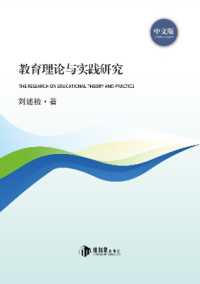- ホーム
- > 洋書
- > 英文書
- > Business / Economics
Full Description
Why and how do some countries title Indigenous lands in some places, and at certain times, but not others? What accounts for the selective implementation of Indigenous people's collective land and natural resource rights? Conventional accounts hold that transnational activism and bottom-up social movements push Indigenous land titling. Other commonly held views are that economic interests and state weakness block these efforts. Giorleny Altamiro Rayo shows Indigenous land titling is neither random nor methodical. Rather, she argues that state elites are motivated to title Indigenous lands to ensure internal order and reinforce the state's territorial power in remote regions.
Rayo unveils how state elites reshape Indigenous peoples' ancestral land claims and transform pre-existing property institutions into a governing mechanism akin to indirect rule. By titling Indigenous lands, state elites create new institutional arrangements in property that allows for the subordination, monitoring, and management of Indigenous society. The broad implication is that state elites subject people that self-identify as Indigenous to a new hierarchical system that perpetuates their political dependency and socioeconomic marginalization. Altamirano Rayo leverages original data from three Latin American countries (Brazil, Honduras, and Nicaragua) and two additional countries of the Global South (Indonesia and Kenya) to propose the theory and test its reach, using a combination of quantitative analysis and comparative case studies of six subnational regions since the 1980s. Rayo develops a new framework to understand the speed and territorial patterns of Indigenous land titling, and invites readers to rethink much of the conventional wisdom about the causes and effects of Indigenous land and natural resource rights allocation.
Contents
List of Tables, Figures, and Maps
Preface
PART I: THEORETICAL FRAMING
Chapter 2: Communal Property Rights of Indigenous Peoples and Ethnic Groups: Their Country-Specific Shape
Chapter 3: The Argument: The Crucial Role of State Interests
PART II:
THE POLITICS OF INDIGENOUS LAND TITLING IN THE AMERICAS
Chapter 4: Nicaragua: Once Bitten, Twice Shy: Titling for Internal Order
Conclusion
Chapter 5: Honduras: Mine not Yours: Indigenous Land Titling to Recover the Eastern Territory
Chapter 6: Brazil: On My Terms: Creating Indigenous Lands to Control the Borderlands
Limitations of Extant Approaches
PART III: CONCLUSION
Chapter 7: New Ethnic Communal Property Regimes: The Devil is in the Details: Legal Implementation, International Norms, and State-Building in the Americas
Appendices
Bibliography








